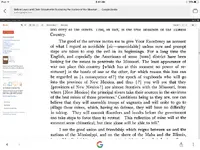This is a good point.
What is interesting to me is, why are the Jesuits sending a priest from Lake of the Woods to some point in Spanish territory when they have priests in Mexico. I can only guess that when the priests entered Mexico, the Spanish authorities would know how many there were and who they were. It seems that if the Jesuits sent a priest in from far to the northeast, it's because they didn't want the Spanish authorities to know that he was in their territory. Why didn't the Jesuits send their priest in from the east or the southeast? During the 1730's the Sauk and Fox tribes were still fighting the French and their allies so this would have made a western approach from Detroit, too dangerous. If the Jesuits had approached Spanish territory from the southeast, the chances are good that they might have encountered Spanish troops or settlers or their Indian allies. So, if the Jesuits were interested in an unobserved incursion, coming in from far to the northeast would make sense.
Now, did the Jesuits have a specific destination or was Aulneau part of an expedition of exploration. I believe that they knew exactly where they were going. Aulneau wrote that he was going 300-400 leagues to the southwest from Lake of the Woods. Here's a link of the Aulneau papers.
https://archive.org/stream/rareaulneaucollect00aulnuoft/rareaulneaucollect00aulnuoft_djvu.txt
On page 67, Father Nau writes to Father Bonin that Aulneau will be 400 leagues from Father Guignas mission which was at Lake Pepin on the Mississippi River. Both of these comments suggest to me that there was a specific destination. Another question would be, did the Jesuits know how close to Mexico 400 leagues to the southwest would be? I believe they did. On pages 57, 66 and 74, the latitudes of three different places in Canada are given and two of them were pretty much right on. The third one, Fort St. Charles was off by a degree and a half to the south. So they knew latitude and they probably knew the latitudes of their missions in the southwest and Mexico, so they would know that it would be much closer to send a priest from Mexico to wherever it was they were going.
So, what was going on? Was there a Vatican inspired expedition, not sanctioned by the French or Spanish government, carried out by the Jesuits? Or could it have been strictly a Jesuit operation?





